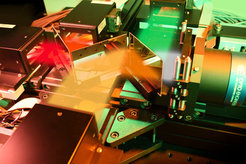Award for best research image
IPP scientist Michael Griener distinguished for “Best Research Image in Plasma Physics”
The prize for the best research image awarded by the scientific journal Europhysics Letters (EPL) among the participants of this year’s plasma physics conference of the European Physical Society (EPS) went to Dr. Michael Griener from Max Planck Institute for Plasma Physics.

The winning photo shows the polychromator system of the helium spectroscopy, which Michael Griener developed and now operates at the Garching fusion device ASDEX Upgrade. The measuring apparatus observes the electrons in the plasma edge and delivers their temperature and density in high spatial and temporal resolution. This is important information because the properties of the plasma boundary layer influence the entire plasma confinement and determine the interaction between the plasma and the vessel wall.
For measurement a beam of helium atoms is sent through the plasma edge. The light they emit in collisions with the plasma particles is collected in 32 optical channels, which correspond to different spatial positions in the plasma, and transmitted through long glass fibres to the polychromator system. A lens (right) focuses the light of the individual fibres on four 32-channel photomultiplier tube arrays, each measuring the intensity of a helium line at 587, 667, 706 and 728 nanometres wavelength. For maximum transmission efficiency, three dichroic mirrors (centre) separate the light into four wavelength bands. In the figure this is artificially illustrated: The mirrors divide the white light from the lens on the right into four colour strips – green, yellow, orange and red. Interference filters directly in front of the photomultipliers then select the specific helium line. In this way, the intensity of the four different helium lines can be measured simultaneously and compared with a theory model. The high light throughput allows for a high measurement frequency of 900 kilohertz, so that even very fast processes such as plasma turbulence can be observed.
According to EPL, the aim of the competition is to promote high-quality visualization work in plasma physics and its explanation in a broadly understandable manner. The competition was open to all attendees of the EPS Plasma Physics Conference 2019, which took place in Milan at the beginning of July. Among the submissions, an international jury made a preselection; the winners were then selected by the 800 conference participants by vote.
